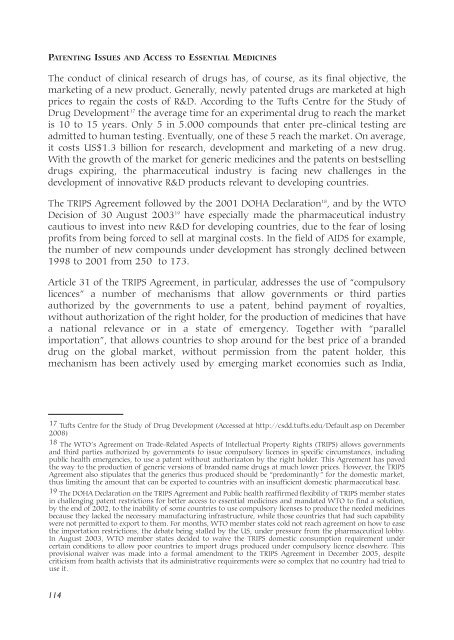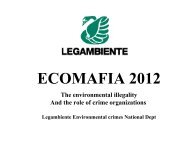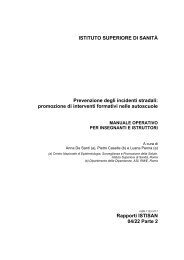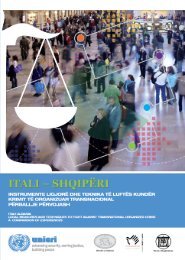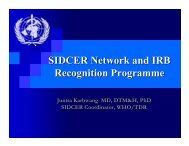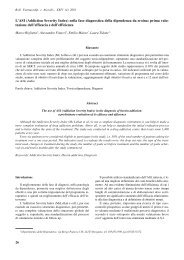Biomedical Research in Developing Countries - UNICRI
Biomedical Research in Developing Countries - UNICRI
Biomedical Research in Developing Countries - UNICRI
Create successful ePaper yourself
Turn your PDF publications into a flip-book with our unique Google optimized e-Paper software.
PATENTING ISSUES AND ACCESS TO ESSENTIAL MEDICINES<br />
The conduct of cl<strong>in</strong>ical research of drugs has, of course, as its f<strong>in</strong>al objective, the<br />
market<strong>in</strong>g of a new product. Generally, newly patented drugs are marketed at high<br />
prices to rega<strong>in</strong> the costs of R&D. Accord<strong>in</strong>g to the Tufts Centre for the Study of<br />
Drug Development 17 the average time for an experimental drug to reach the market<br />
is 10 to 15 years. Only 5 <strong>in</strong> 5.000 compounds that enter pre-cl<strong>in</strong>ical test<strong>in</strong>g are<br />
admitted to human test<strong>in</strong>g. Eventually, one of these 5 reach the market. On average,<br />
it costs US$1.3 billion for research, development and market<strong>in</strong>g of a new drug.<br />
With the growth of the market for generic medic<strong>in</strong>es and the patents on bestsell<strong>in</strong>g<br />
drugs expir<strong>in</strong>g, the pharmaceutical <strong>in</strong>dustry is fac<strong>in</strong>g new challenges <strong>in</strong> the<br />
development of <strong>in</strong>novative R&D products relevant to develop<strong>in</strong>g countries.<br />
The TRIPS Agreement followed by the 2001 DOHA Declaration 18 , and by the WTO<br />
Decision of 30 August 2003 19 have especially made the pharmaceutical <strong>in</strong>dustry<br />
cautious to <strong>in</strong>vest <strong>in</strong>to new R&D for develop<strong>in</strong>g countries, due to the fear of los<strong>in</strong>g<br />
profits from be<strong>in</strong>g forced to sell at marg<strong>in</strong>al costs. In the field of AIDS for example,<br />
the number of new compounds under development has strongly decl<strong>in</strong>ed between<br />
1998 to 2001 from 250 to 173.<br />
Article 31 of the TRIPS Agreement, <strong>in</strong> particular, addresses the use of “compulsory<br />
licences” a number of mechanisms that allow governments or third parties<br />
authorized by the governments to use a patent, beh<strong>in</strong>d payment of royalties,<br />
without authorization of the right holder, for the production of medic<strong>in</strong>es that have<br />
a national relevance or <strong>in</strong> a state of emergency. Together with “parallel<br />
importation”, that allows countries to shop around for the best price of a branded<br />
drug on the global market, without permission from the patent holder, this<br />
mechanism has been actively used by emerg<strong>in</strong>g market economies such as India,<br />
17 Tufts Centre for the Study of Drug Development (Accessed at http://csdd.tufts.edu/Default.asp on December<br />
2008)<br />
18 The WTO’s Agreement on Trade-Related Aspects of Intellectual Property Rights (TRIPS) allows governments<br />
and third parties authorized by governments to issue compulsory licences <strong>in</strong> specific circumstances, <strong>in</strong>clud<strong>in</strong>g<br />
public health emergencies, to use a patent without authorizaton by the right holder. This Agreement has paved<br />
the way to the production of generic versions of branded name drugs at much lower prices. However, the TRIPS<br />
Agreement also stipulates that the generics thus produced should be “predom<strong>in</strong>antly” for the domestic market,<br />
thus limit<strong>in</strong>g the amount that can be exported to countries with an <strong>in</strong>sufficient domestic pharmaceutical base.<br />
19 The DOHA Declaration on the TRIPS Agreement and Public health reaffirmed flexibility of TRIPS member states<br />
<strong>in</strong> challeng<strong>in</strong>g patent restrictions for better access to essential medic<strong>in</strong>es and mandated WTO to f<strong>in</strong>d a solution,<br />
by the end of 2002, to the <strong>in</strong>ability of some countries to use compulsory licenses to produce the needed medic<strong>in</strong>es<br />
because they lacked the necessary manufactur<strong>in</strong>g <strong>in</strong>frastructure, while those countries that had such capability<br />
were not permitted to export to them. For months, WTO member states cold not reach agreement on how to ease<br />
the importation restrictions, the debate be<strong>in</strong>g stalled by the US, under pressure from the pharmaceutical lobby.<br />
In August 2003, WTO member states decided to waive the TRIPS domestic consumption requirement under<br />
certa<strong>in</strong> conditions to allow poor countries to import drugs produced under compulsory licence elsewhere. This<br />
provisional waiver was made <strong>in</strong>to a formal amendment to the TRIPS Agreement <strong>in</strong> December 2005, despite<br />
criticism from health activists that its adm<strong>in</strong>istrative requirements were so complex that no country had tried to<br />
use it.<br />
114


